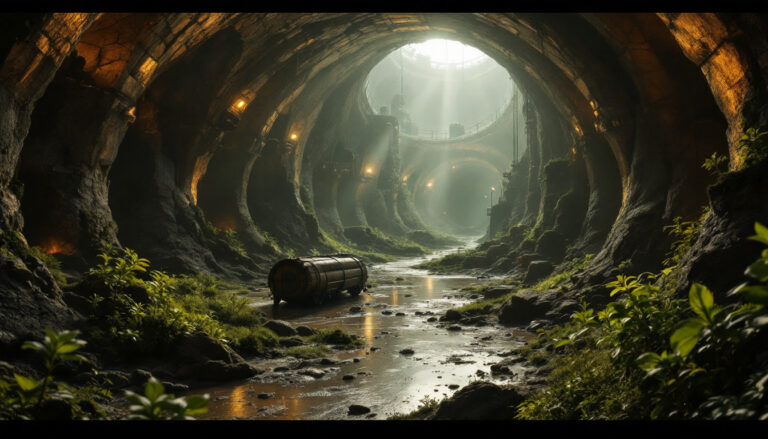Shift by Hugh Howey – A Book Review
Imagine a world where humanity lives entombed in underground silos, each housing thousands of people who are shielded from a toxic surface. Hugh Howey’s Shift, the prequel to the bestselling Wool, unpacks the origins of this dystopian reality and weaves an intricate tale of control, survival, and the fragility of truth. But does this follow-up meet the high expectations set by its predecessor? Let’s explore.
The Stakes: What Shift Is All About
Set decades before the events of Wool, Shift delves into the catastrophic events that led to the creation of the Silo system. It reveals how a seemingly sustainable project spiraled into dystopian control. Structured as three connected novellas—First Shift, Second Shift, and Third Shift—the story spans years and perspectives, tying together the threads of conspiracy, betrayal, and human endurance.
At its core, Shift examines how power can crush trust. By peeling back layers of the Silo system’s origins, we see how societal manipulation was embedded into its foundations. Every shift of duty within the Silos is not just a logistical operation but a carefully orchestrated mechanism of control.
For a deeper dive into the series, you can explore additional context about Silo on Wikipedia.
Characters Struggling in the Machine
The prequel introduces pivotal new characters. Donald Keene, a reluctant architect of the Silo project, emerges as the emotional anchor. His transformation from an idealistic congressman to a guilt-stricken pawn in something far larger feels deeply human. Through Donald, Howey offers a relatable window into the systemic decisions that doom humanity to a life underground.
Another highlight is Senator Paul Thurman, the driving force behind the project. Representing the ruthless pursuit of survival at any cost, Thurman’s actions show how ambition, cloaked in the guise of protection, can wreak havoc. His cold pragmatism is haunting, especially when contrasted with Donald’s internal struggles.
Fans of detailed character arcs can further explore these nuances by checking out insights from this Goodreads review of the book.
A Sense of Dread: Howey’s Writing Style
Howey taps into a visceral sense of claustrophobia and unease throughout Shift. The silos, though massive, feel like prisons. Readers can almost hear the hum of machinery and the whispers of confined lives. The weight of isolation hangs over every scene.
But the writing excels most in its exploration of moral dilemmas. Howey doesn’t spoon-feed villains and heroes but rather paints a world where choices are complex. The juxtaposition of hope and despair in Shift keeps readers engaged and questioning what they’d do in similar circumstances.
If you’d like to read more about why Howey’s writing resonates, this review from The Guardian discusses the atmospheric tension in the book.
What Worked — and What Didn’t
One of Shift’s greatest strengths is the way it enriches the world introduced in Wool. It answers big questions about how the Silos came to be and why society chose this insulated form of survival. For readers craving backstory, Shift is a treat.
However, some readers might find its pacing uneven at times. The first two sections provide gripping setups, but the final novella leans heavily on exposition. The emotional punch in certain moments doesn’t always land, as Howey juggles expansive timelines and numerous plot points.
Readers on forums like Reddit note that Shift’s narrative style feels more polished than Wool, but it occasionally sacrifices character depth for world-building.
Key Themes in Shift
Beyond its dystopian thrills, Shift probes the ethics of governance, memory, and survival. The Silos aren’t just bunkers—they’re elaborate systems of social engineering. IT departments suppress dissent, and lies about the outside world keep residents complacent. Humanity’s fear is weaponized to sustain control.
The recurring theme of memory stands out. For those in Silo 1, memories of the old world are preserved through cryogenic stasis, creating a painful contrast with the amnesia imposed on lower-tier Silos. This creates a dynamic tension: how much of the past should be preserved, and at what cost?
For more on these thematic depths, visit this no-spoiler review of Shift, which points to Howey’s exploration of control and rebellion.
Final Thoughts: Is Shift Worth Your Time?
Shift is more than a prequel—it’s a haunting study in cause and effect, showing how noble intentions can crumble under the weight of fear and power. While it may not carry the same punch as Wool, its revelations complement the series as a whole, making it essential reading for those eager to understand the full scope of the Silo saga.
Whether you’re drawn to dystopian tales, complex characters, or philosophical questions about humanity’s path, Shift delivers a thought-provoking story. If you haven’t yet picked it up, it’s worth exploring—especially if you plan to dive deeper into the Silo series, which you can learn more about on Hugh Howey’s official site.
What do you think about the world of silos? Could humanity survive its own controlled environment? Let us know your thoughts in the comments!







